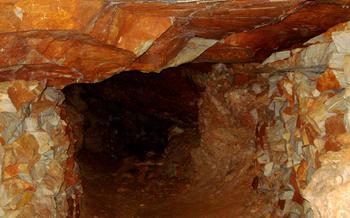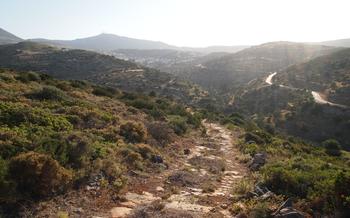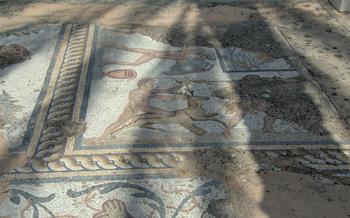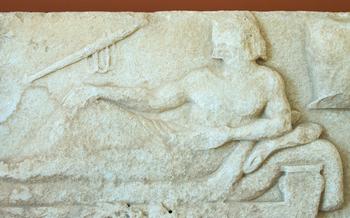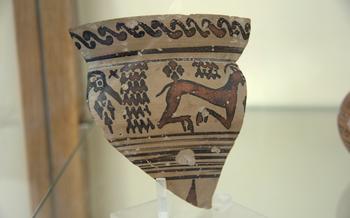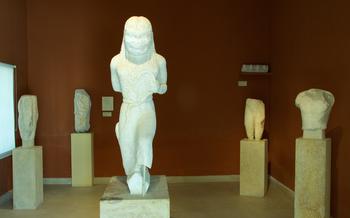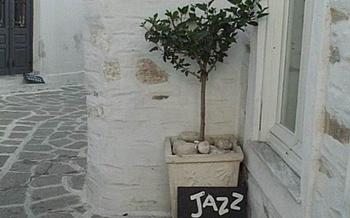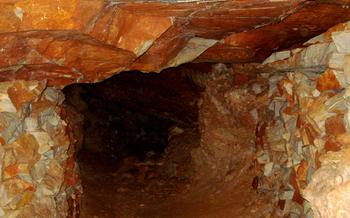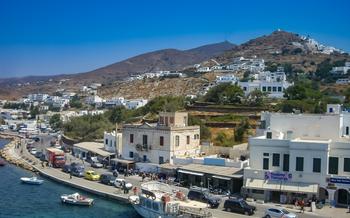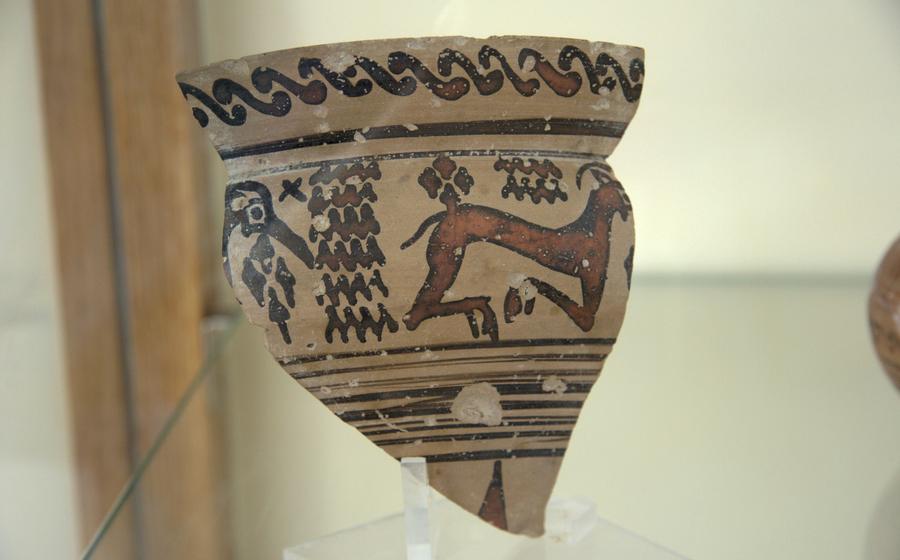
Marathi Marble Quarries
- Historical Significance
- Geological Formation
- Quarrying Techniques
- Transportation and Trade
- Abandoned Quarries
- Visiting the Quarries
- Guided Tours
- Marble Workshops and Demonstrations
- Local Cuisine and Hospitality
- Nearby Attractions
- Photography Opportunities
- Environmental Responsibility
- Respecting Local Customs
- Insider Tip: Unveiling the Hidden Beauty of Marathi Quarries
Historical Significance
The Marathi Marble Quarries hold immense historical significance, dating back to ancient times when Paros was renowned for its exceptional marble. The island's quarries supplied the finest quality white marble, known as Parian marble, which was highly prized by ancient Greek architects and sculptors. Parian marble was used to construct some of the most iconic structures of classical Greece, including the Temple of Apollo in Delphi, the Parthenon in Athens, and the Aphrodite of Milos statue. The quarries were not merely a source of building material but also a testament to the artistic and cultural achievements of the ancient Greeks. They represent a tangible link to the past, offering a glimpse into the craftsmanship and ingenuity of a civilization that shaped Western culture.
Geological Formation
The Marathi Marble Quarries are a testament to the remarkable geological processes that shaped the island of Paros. The marble found here is the result of a unique combination of geological events that occurred over millions of years. The original limestone deposits were subjected to intense heat and pressure, causing them to recrystallize and transform into marble. This process, known as metamorphism, resulted in the formation of the distinctive white marble that is characteristic of Paros.
The marble in the Marathi quarries is composed primarily of calcium carbonate, with trace amounts of other minerals that contribute to its unique characteristics. The white color of the marble is due to the absence of impurities, while its fine grain and crystalline structure give it a smooth and lustrous appearance. The quarries also contain different types of marble, each with its own distinct color and pattern. These variations are a result of differences in the mineral composition and the conditions under which the marble formed.
Understanding the geology of the Marathi Marble Quarries is essential for appreciating their significance. The unique geological processes that created this natural wonder have resulted in a material that has been prized for its beauty and durability for centuries.
Quarrying Techniques
The ancient Greeks employed traditional methods to extract marble from the Marathi quarries, relying on hand tools and simple machinery. Skilled quarry workers used chisels, wedges, and levers to separate the marble blocks from the bedrock. The process required immense physical strength and precision to ensure the integrity of the marble and minimize wastage.
Despite the lack of modern equipment, the ancient Greeks demonstrated remarkable ingenuity and skill in their quarrying techniques. They developed a system of ramps and levers to transport the massive marble blocks from the quarries to the port, where they were loaded onto ships for transportation to other parts of the Greek world.
The challenges faced by the ancient quarry workers were immense. They worked in harsh conditions, exposed to dust, heat, and the risk of injury from falling rocks and heavy machinery. The quarrying process was labor-intensive and time-consuming, requiring patience, perseverance, and a deep understanding of the material they were working with.
Transportation and Trade
The quarried marble from Paros was transported to other parts of the Greek world through sea trade. Ships played a crucial role in distributing Parian marble, taking advantage of the island's strategic location in the Aegean Sea. The marble was loaded onto vessels at the ancient port of Paroikia and sailed to various destinations.
The transportation of marble was a significant undertaking, requiring careful planning and coordination. Ships had to be sturdy enough to withstand the open waters and transport heavy loads of marble. The routes taken by the ships were carefully chosen to avoid dangerous weather conditions and potential hazards.
The distribution of Parian marble through sea trade had a profound impact on the economy of ancient Greece. The marble industry in Paros flourished, generating wealth and prosperity for the island. The quarries became a hub of commercial activity, attracting merchants and traders from across the region.
The trade in Parian marble also facilitated cultural exchange and artistic collaboration. As the marble was used in the construction of temples, theaters, and other public buildings, it carried with it the influence of Parian craftsmanship and artistry. The circulation of Parian marble contributed to the spread of classical Greek architecture and aesthetics throughout the Mediterranean.
Abandoned Quarries
The Marathi Marble Quarries were eventually abandoned due to a combination of factors. Changing technologies in the quarrying industry made traditional methods less efficient, and the rise of alternative sources of marble from other regions led to a decline in demand for Parian marble. Economic factors also played a role, as the cost of extracting marble from the quarries became increasingly expensive.
Today, the abandoned quarries stand as a silent testament to the ingenuity and skill of the ancient Greeks. The massive marble blocks, partially extracted from the earth, offer a glimpse into the arduous process of quarrying in ancient times. The site has been designated as a protected historical monument, and efforts are underway to preserve and restore the quarries for future generations. Visitors can explore the abandoned quarries and marvel at the sheer scale and grandeur of these ancient works.
Visiting the Quarries
Visiting the Marathi Marble Quarries is a unique and rewarding experience that offers a glimpse into the ancient world of marble quarrying. The quarries are easily accessible by car or public transportation, and there is ample parking available at the site. The best time to visit is during the spring or fall, when the weather is pleasant and the crowds are smaller. Visitors should wear comfortable shoes and clothing, as the terrain can be uneven and dusty. There is a small entrance fee to visit the quarries, which helps to support their preservation and maintenance.
Guided Tours
Exploring the Marathi Marble Quarries with a knowledgeable guide offers a rich and immersive experience. Experienced guides provide valuable insights into the history, geology, and significance of the site. They can explain the quarrying techniques, transportation methods, and cultural impact of Parian marble in ancient Greece. Guided tours often include anecdotes and stories that bring the past to life, making the visit even more engaging. Booking a tour in advance, especially during the peak tourist season, is recommended to secure a spot and avoid disappointment. Different tour options are available, including group tours for a social experience and private guided tours for a more personalized exploration.
Marble Workshops and Demonstrations
Paros is renowned for its marble craftsmanship, and visitors to the island have the opportunity to witness the art of marble working firsthand. Several workshops and studios are scattered across the island, where skilled artisans showcase their traditional techniques and create exquisite marble sculptures, jewelry, and other objects.
Attending a marble carving demonstration is a fascinating experience that allows visitors to gain a deeper understanding of the ancient craft. Artisans use simple tools and meticulous hand movements to transform raw marble into intricate works of art, demonstrating the patience and skill required in this delicate process.
Visitors can observe the artisans as they carefully select and cut the marble, using chisels, hammers, and other tools to shape and refine the material. They can also witness the polishing process, where artisans use abrasive materials to bring out the marble's natural luster and achieve a smooth, glossy finish.
These workshops often welcome visitors and provide opportunities to interact with the artisans, learn about their techniques, and even try their hand at basic marble carving under their guidance. It's a unique and immersive experience that allows visitors to appreciate the artistry and craftsmanship behind the beautiful marble creations that adorn Paros and beyond.
Local Cuisine and Hospitality
Paros is renowned for its culinary delights, offering a tantalizing array of fresh seafood and traditional Greek dishes that will tantalize your taste buds. Indulge in the flavors of "Parian Salad," a refreshing mix of tomatoes, cucumbers, onions, and capers, dressed in a tangy vinaigrette. Savor the succulent "Octopus Stifado," a slow-cooked octopus stew simmered in a rich tomato sauce, infused with herbs and spices. The island's warm hospitality and friendly locals add to the charm, ensuring you feel welcomed and at home. Immerse yourself in the authentic flavors and culture of Paros by visiting local tavernas and restaurants, where you can relish mouthwatering dishes while experiencing the vibrant atmosphere of Greek cuisine.
Nearby Attractions
Apart from the captivating Marathi Marble Quarries, Paros boasts a wealth of other attractions that will enrich your visit to the island. Explore the charming village of Naoussa, renowned for its picturesque harbor, whitewashed houses adorned with colorful bougainvillea, and vibrant nightlife. Wander through the narrow cobblestone streets, discover hidden gems like the Folklore Museum, and savor delicious seafood delicacies at the waterfront tavernas.
Venture to the traditional village of Lefkes, nestled amidst rolling hills and boasting breathtaking views of the Aegean Sea. Admire the well-preserved Cycladic architecture, visit the Byzantine Church of Agios Ioannis Prodromos, and indulge in local delicacies at the village's charming tavernas.
For a spiritual and historical immersion, visit the Panagia Ekatontapyliani Church, a magnificent Byzantine masterpiece located in the heart of Parikia, Paros' main town. Marvel at the stunning mosaics that adorn its interior and delve into the rich history of this sacred site, which has stood as a testament to Paros' religious heritage for centuries.
Embrace the island's natural beauty by exploring its pristine beaches. Discover secluded coves with crystal-clear waters, perfect for swimming, snorkeling, and sunbathing. From the golden sands of Kolymbithres Beach to the tranquil shores of Parasporos Beach, Paros offers a diverse range of coastal experiences to suit every preference.
Photography Opportunities
The Marathi Marble Quarries offer a treasure trove of photographic opportunities for enthusiasts of all skill levels. The vast expanse of gleaming white marble formations, set against the backdrop of the deep blue Aegean Sea, creates a visually stunning landscape. With careful composition, photographers can capture the unique textures, patterns, and shapes that characterize the quarries. Using a wide-angle lens allows photographers to capture the grandeur of the site, while experimenting with different lighting conditions, especially during sunrise and sunset, can produce dramatic and evocative images. Whether you're an experienced photographer or simply enjoy capturing memories, the Marathi quarries provide endless possibilities for creating beautiful photographs that will forever remind you of your visit to this extraordinary place.
Environmental Responsibility
As responsible travelers, it is essential to minimize our impact on the environment when visiting the Marathi Marble Quarries. Respecting the natural beauty and preserving the ecosystem for future generations are crucial. Here are some tips for practicing environmental responsibility during your visit:
-
Reduce Waste: Avoid single-use plastics by bringing your own water bottle and reusable bags. Dispose of waste properly in designated bins to prevent littering.
-
Respect the Environment: Refrain from touching or climbing on the marble formations to prevent damage. Avoid disturbing the local flora and fauna, and keep noise levels to a minimum to maintain the tranquil atmosphere of the quarries.
-
Support Local Initiatives: Choose tour operators that prioritize sustainability and support local conservation efforts. Consider volunteering or donating to organizations dedicated to preserving the quarries and the surrounding environment.
By following these guidelines, we can help protect the Marathi Marble Quarries and ensure that their beauty and historical significance are preserved for generations to come.
Respecting Local Customs
When visiting Paros, it is important to be mindful of local customs and traditions to ensure a respectful and enjoyable experience. Dressing appropriately in public places is essential, avoiding overly revealing or offensive clothing. When visiting religious sites, such as the Panagia Ekatontapyliani Church, it is customary to dress modestly and cover shoulders and knees. Learning a few basic Greek phrases, such as "hello," "thank you," and "goodbye," can go a long way in showing respect for the local culture and facilitating communication with locals. Engaging with locals in a friendly and respectful manner is always appreciated and can lead to meaningful interactions and insights into the island's way of life. By observing local customs and traditions, visitors can contribute to preserving the unique character and charm of Paros while creating a positive and harmonious experience for all.
Insider Tip: Unveiling the Hidden Beauty of Marathi Quarries
Beyond the well-trodden paths of the Marathi quarries lies a hidden gem, a secluded spot that offers breathtaking views and a tranquil ambiance. Tucked away amidst the labyrinthine marble formations, this secret spot invites you to discover the true essence of the quarries.
To reach this hidden paradise, venture off the main trails and follow a narrow path that leads deeper into the quarry. As you navigate through the majestic marble walls, the surrounding landscape transforms, revealing a secluded oasis untouched by the crowds.
The reward for your adventurous spirit is a panoramic vista that will leave you spellbound. From this vantage point, you can witness the mesmerizing interplay of light and shadow as the sun casts its golden rays upon the pristine marble surfaces. The surrounding hills and the distant sea create a breathtaking backdrop, painting a picture of unspoiled natural beauty.
For an even more immersive experience, plan your visit during the early morning hours or just before sunset. At these times, the quarries exude a magical glow, as the soft light enhances the intricate details of the marble formations. Capture the ethereal beauty of the moment with your camera or simply soak in the tranquility, allowing the serene atmosphere to soothe your soul.
To fully appreciate the hidden wonders of the Marathi quarries, consider combining your visit with other activities that showcase the island's rich heritage. Embark on a boat trip to explore the secluded coves and crystal-clear waters that surround Paros. Alternatively, lace up your hiking boots and embark on a trek through the picturesque mountains, discovering hidden trails and panoramic viewpoints along the way.
If you're fortunate enough to visit during the summer months, keep an ear out for special events or festivals that celebrate the island's marble heritage. These vibrant gatherings offer a unique opportunity to immerse yourself in the local culture and gain deeper insights into the history and significance of the Marathi quarries.
